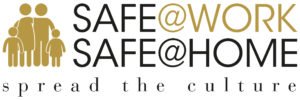SHP speaks to Malcolm Staves, Group Health & Safety Director at L’Oréal about safety culture, leadership and the successful social responsibility programme, Safe@Work, Safe@Home.

“I’m a big believer in the hummingbird theory when it comes to creating a successful sustainable safety culture” Malcolm Staves tells SHP early on in our conversation.
A slightly baffling statement for the uninitiated to be sure. To understand what he means, we must first take the time to tell a story that will illuminate Stave’s point.
One day, a huge fire breaks out in the forest. All the animals see the fire and feel the heat and begin to run away. As they do, they see a little hummingbird flying back and forth between the water and the fire’s edge. He takes a little water in his mouth from the river, flies back to the fire and spits out the water. Back and forth, back and forth between the river and the fire.
“Little Hummingbird, what are you doing?!”” The other animals cried, “Stop it or else the fire will get you!”
“I’m doing my best” replied the little hummingbird, “and if we all did a little we’d get a lot done!”
So the animals of the forest rally together and put the fire out completely, saving their woodland home.
The moral of the story is clear to see, a big change can and will be made by everyone doing a little bit on their own part.
“This is what we did at L’Oréal. By getting the 89,000 staff spread over every level of L’Oréal to get involved and do a little bit of work to improve their workplace safety we’ve seen a huge improvement in safety!” Staves tells us.
“The people working on our shop floors and the people working in our shops don’t necessarily see what statistics [about how things have gotten better] represent/mean . But if we show them how things have improved and encourage them to do a little bit each and every day in health and safety, then those 89,000 small actions will make a big difference. It can really count in the long run. This is the Hummingbird theory in action”
It’s hard to argue with this slightly out-of-the-box theory when you see the results. Since this approach was integrated into programmes on reporting Safety Improvement Opportunities (SIOs), Management safety visits, targeted training programs and culture audits and these programmes became company policy from 2008, L’Oréal to date have enjoyed an increase in safety performance of almost 70%. This is equivalent to over 1,365 lost time accidents avoided in the last 10 years.
Building a safety culture
Staves’ initiatives have had wildly successful results and the safety performance at L’Oréal has continued to improve year after year. We asked Staves what he thinks a company needs to do to build a safety culture as successful as L’Oréal’s.
“The leadership needs to be visible and safety seen as a core value. To really make an impact you need to be visible in the field. Speak to people, let them know what’s happening, make safety personal to them and then deliver on your promises or on actions that you have agreed to. Safety is also about credibility; credibility of the management and safety professionals to deliver. ”
People get to see their line managers taking care of their safety as individuals, with their concerns and practices, not just talking about equipment. The success comes from making safety personal; safety is suddenly physically real and becomes a bigger force in the worker’s mind because my “boss” cares for me.
“Having a proper handle on what your most important risks is really important. Being able to identify these risks and act to prevent them from affecting your workforce is vital. In L’Oréal we talk about LIFE* risks that need to be under control in all our sites”.
“Finally, you have to make sure that within your company the entire workforce stays focused on their contribution on a day to day basis, on helping manage risks and developing the safety culture. Safety should be a forefront of everyone’s mind.”
Incorporating h&s at home
Staves’ passion for building a solid risk management approach and an excellent safety culture at L’Oreal is clear to see as well as his strong beliefs that building a resilient safety culture at work should have an impact and improve safety at home.
“A Company as big as ours has the potential to have a positive impact beyond its gates and therefore we have an important role to play in keeping people safe no matter where they are. If we can spread our safety culture through our employees to their families and friends then society will gain from our efforts. In addition, we want them to want to work safely for their families and not “just” for L’Oréal. I know it sounds like a cliché but if we can get all employees to think and act safely with their families and develop a mindset where people are conscious that they want to return home to their families as they came to work in the morning then it’s a win for everyone. With this in mind, we’ve recently launched a programme called ‘Safe@Work,-Safe@Home’.”
 “The programme is this: L’Oréal sites develop initiatives that promote not just being “safe@work” but also being “safe@home”. People are encouraged to take this information and use it at home, according to the Hummingbird theory this will gain more and more momentum. Hopefully an employee would then then encourage his friends and family to tell their friends and family about health and safety. Ultimately, everyone even vaguely attached to our employees is safer and more mindful of the day-to-day risks they might face.”
“The programme is this: L’Oréal sites develop initiatives that promote not just being “safe@work” but also being “safe@home”. People are encouraged to take this information and use it at home, according to the Hummingbird theory this will gain more and more momentum. Hopefully an employee would then then encourage his friends and family to tell their friends and family about health and safety. Ultimately, everyone even vaguely attached to our employees is safer and more mindful of the day-to-day risks they might face.”
“The humming bird theory in action!” exclaims Staves. “If the 89,000 employees we have at L’Oréal talk about safety to their friends and change just one small thing then maybe an accident may be prevented or life will be improved. Adopting some of our internal safety culture into their personal life can have a huge effect!”
“And this programme works! In our department, we offered our employees a fire extinguisher for their home and taught them how to use it properly. About three months later, an employee came up to me and said that they had put a fire out in their apartment with the extinguisher we have given them.”
Risks
No matter how strong a safety culture, any multinational company has to tackle a lot of different risks in day-to-day operations. L’Oréal is no different.
“We face different risks over a lot of different areas” explains Staves. “From our plants to our stores, from our administrative sites to our R&I laboratories, we have to be mindful of the different dangers our employees can face. We need to plan to avoid the unthinkable as well as the thinkable”
“You can never truly eliminate the element of risk. However what you need is to ensure that the risks are identified and are under control, through procedures, risk assessments etc. You also need provide people with the training and reflexes so that when faced with a risk they identify it and react accordingly to manage the risk. This is where safety culture and risk intersect”.
“For example, we have to make sure we have trained people to drive forklift trucks, we need people to pay attention when walking down stairs or handling cartons of products.”
Staves also acknowledges that keeping employees safe can also pose internal challenges.
“Sometimes we go into a workplace with our health & safety hats on knowing exactly what we want to do and how to do it. This is all well and good but we need to look at the situation with the eyes of the person that will implement the initiative/program”
“Everyone agrees that safety is important, but safety professionals also need to understand that everyone has their own set of challenges and they need to adapt as leaders to get their message over. The future of a safety professional is not just to be an expert but also to be a good leader, communicator, trainer and coach. Working together as teams with the brands, sites and other function to solve problems and challenges is the best way to evolve the safety culture to the next level. The work is never finished for a safety professional as we all drive towards excellence and beyond”.
*LIFE: LIfe threatening Incident or Fatality Event.
Malcolm Staves is a Fellow of the Institution of Chemical Engineers and graduated from Loughborough University with a degree in Chemical Engineering. He has an MSc in Integrated Environmental Management and is currently studying for an MSc in Ergonomics. He is the current chairman of the Conference of the Board European Health & Safety Council, which has around thirty members.
Previously a site engineering technologist and a plant manager he has worked in Corporate Environment and, Health & Safety for companies including Pechiney, Alcan and Bureau Veritas. He joined L’Oréal in 2008 as Group Health & Safety Director, where he is responsible for the development of Group Health, Safety and Fire Prevention strategies, objectives and action plans.
The Safety Conversation Podcast: Listen now!
The Safety Conversation with SHP (previously the Safety and Health Podcast) aims to bring you the latest news, insights and legislation updates in the form of interviews, discussions and panel debates from leading figures within the profession.
Find us on Apple Podcasts, Spotify and Google Podcasts, subscribe and join the conversation today!


 “The programme is this: L’Oréal sites develop initiatives that promote not just being “safe@work” but also being “safe@home”. People are encouraged to take this information and use it at home, according to the Hummingbird theory this will gain more and more momentum. Hopefully an employee would then then encourage his friends and family to tell their friends and family about health and safety. Ultimately, everyone even vaguely attached to our employees is safer and more mindful of the day-to-day risks they might face.”
“The programme is this: L’Oréal sites develop initiatives that promote not just being “safe@work” but also being “safe@home”. People are encouraged to take this information and use it at home, according to the Hummingbird theory this will gain more and more momentum. Hopefully an employee would then then encourage his friends and family to tell their friends and family about health and safety. Ultimately, everyone even vaguely attached to our employees is safer and more mindful of the day-to-day risks they might face.”
